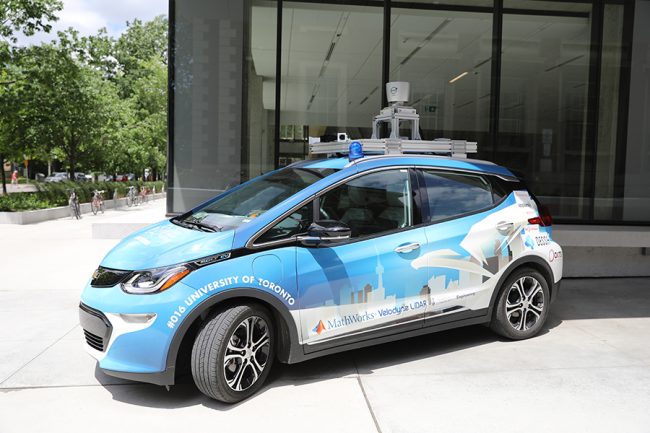
aUToronto has placed first in an intercollegiate challenge to transform an electric car into a self-driving one — their third consecutive win.
“All of us take pride in the work that we have done at aUToronto,” says Jingxian “Joe” Qian (EngSci 1T8 + PEY, UTIAS MASc candidate), Team Lead for aUToronto. “The competition results clearly reflect the high calibre and dedication of the team.”
The team also took the top overall prize for the most cumulative points over the three years of the AutoDrive Challenge. Second place went to Texas A & M, with Virginia Tech scoring third. The other schools in the competition were: University of Waterloo, Michigan State, Michigan Tech, North Carolina A&T State, and Kettering University.
The AutoDrive Challenge began in 2017, when each of the student-led teams was provided with a brand-new electric vehicle, a Chevrolet Bolt. Their task was to convert it into an autonomous vehicle, meeting yearly milestones along the way.
Sponsors of the AutoDrive include General Motors, the Society of Automotive Engineers (SAE) and a number of other companies that produce hardware and software for self-driving cars.
The U of T team took the top spot at the first meet of the competition, held in the spring of 2018 at the General Motors Proving Grounds in Yuma, Ariz. In the second year, they again placed first at the competition, which took place in MCity, a simulated town for self-driving vehicle testing, built at the University of Michigan in Ann Arbor.

The third yearly meet was originally scheduled to take place last spring at the Transportation Research Center in East Liberty, Ohio. However, it was postponed and reorganized due to the global COVID-19 pandemic.
“The goal of this year’s challenge was to simulate an autonomous ride-sharing scenario,” says Qian. “That means the car needed to arrive at a sequence of pre-determined address points and perform pseudo pick-up and drop-off behaviours. The routes would have been much longer and more complex compared with Year 2.”
In the absence of a live event, the organizers used what are known as “static event” scores, which are based on reports and presentations that the teams could submit remotely. These included an analysis of the social responsibility aspects of the project, the overall conceptual design and the results of a number of sophisticated computer simulations.
Qian says that the latest iteration of Zeus includes a number of enhancements, including improvements in perception, path planning and GPS-free localization. To make them, the aUToronto team overcame numerous challenges, not the least of which was coordinating more than 50 team members who were working remotely on the project.
“We are located in many different places around the world, so team building and organization becomes extremely important,” says Qian. “We have weekly meetings online where sub-team leads present their updates to the rest of the team, and we have also been planning virtual paper talks and knowledge sharing sessions.”
“As a faculty advisor, I have watched with awe as the 100%-student-run team really seized this unique opportunity,” says Professor Tim Barfoot (UTIAS). Barfoot, along with Professor Angela Schoellig (UTIAS) is one of the two co-Faculty Leads of the team. He also serves as Associate Director of the University of Toronto Robotics Institute and the Chair of the Robotics Option offered by the Division of Engineering Science.
“Robotics is a very hands-on discipline, so experiences such as the AutoDrive Challenge are needed to complement classroom learning,” says Barfoot “I am deeply grateful to SAE and GM for organizing this activity and the Faculty of Applied Science and Engineering for their ongoing support through the Dean’s Strategic Fund. I feel our graduates are better prepared to head into the exciting field of autonomous vehicles than perhaps anywhere in the world at this moment in time. The fact that we won the competition is a bonus.”
The competition has been rolled into a fourth year, with a live meet set to take place sometime in 2021, again at MCity in Ann Arbour, Mich. But aUToronto is also thinking beyond the end of the AutoDrive Challenge.
“We are looking towards Year 4 and we are ready to tackle more challenges,” says Qian. “But we’ve always said we do not want to design a system that is specific towards this competition. Our goal is to achieve full autonomy under many different scenarios.”
See the full story by Tyler Irving on Engineering News.
Check out this video by aUToronto’s about preparing for the Y3 challenge:
SAE Awards Video:
